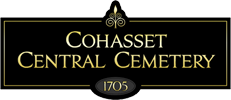An Old New England Village Green
David Wadsworth
Reproduced, with permission, from Treasury of Cohasset History, ed. J. M. Dormitzer (Town of Cohasset, Mass., 2005), pp. 39-41.
Cohasset’s Town Common is often called the finest example of an old New England village green to be found in this area. Its history goes back to the late 1600s, long before Cohasset became a town or even was a lived-in part of Hingham. When Hingham was settled during the 1630s, its vacant eastern section, called Conahasset, was visited by farmers traveling to the shores to harvest salt hay. By 1670 Hingham “proprietors,” or landowners, decided to divide the upland areas of Conahasset and parcel it out to each property owner of the town.
Lieutenant Joshua Fisher of Dedham was hired to survey the land and mark out each man’s share. The founding of Cohasset as an outlying village of Hingham dates from that land division. In the map drawn by Joshua Fisher, each Hingham proprietor received a share of the previously undivided common land of Conahasset, and soon the first farms and homesteads were built in the newly opened upland areas.
Fisher’s map left undivided the salt marshes along the shores. It also left under common ownership a large tract of uplands extending from Little Harbor on the north to Cohasset Harbor on the south. This area, labeled on Fisher’s map simply as “Plain,” is today’s Cohasset Common.
Through many years, new arrivals in Cohasset encroached and built dwellings upon the fringes of the remaining common land, especially its southern and eastern parts along today’s Elm Street, and in the early 1800s the town conveyed the encroached land to its occupants but halted further encroachment. Thus the boundaries of Cohasset’s Common were defined and remain essentially the same today. During the 1920s an organization of homeowners called the Cohasset Improvement Association purchased part of the previously encroached land at the lower end of the Common, razed a group of stores located there, and presented the area to the town to make it once again part of the Common.
In about 1714 residents of the Cohasset area constructed their first meetinghouse on the Common, just a few yards south of the present First Parish Meeting House. That building was taken down after the present church was built in 1747. Cohasset became the Second, or East, Precinct of Hingham in 1717, and its meetinghouse became Hingham’s Second Parish at the same time. The Common’s western and southern boundaries were marked by today’s North Main Street, an ancient way leading from the original Hingham settlement to the village at Scituate.
By the year 1700 several farms and dwellings existed along the highway, and soon Main Street became lined with residences, particularly surrounding the Common area. By the time Cohasset became a town separate from its parent, Hingham, in 1770, the Common land was the center of activities for the new community. Local militia often drilled at the Common, and [in the early 1980s] an old cannon ball was unearthed by residents in a nearby yard.
Today’s Common is flanked by residences of diverse architectural styles ranging from early Georgian or Federal or Colonial to ornate Italianate Victorian and Classical Revival, all representing the several major architectural eras through which our nation passed. The Town Hall was constructed in the 1850s, the Second Congregational Church in the 1820s, and, nearby atop Bourne’s Rock, Saint Stephen’s Episcopal Church dates from the 1890s.
The Common Pond, in early days called the Frog Pond, is a natural feature, having been a small glacial punchbowl. During parts of the nineteenth century, the Common was fenced in to keep out wandering animals, but ducks and geese seem to have inhabited the Frog Pond since the earliest days, as the ducks still see fit to do.
A feature of the nineteenth-century Common was an ornate bandstand, located across the street from the Town Hall. At the north end of the Common, the town’s flagpole was presented to the townspeople in the early 1900s by the family of George G. Crocker, and nearby is found the Daughters of the American Revolution’s memorial boulder and plaque dedicated to Cohasset’s Revolutionary War soldiers and sailors.
Among the stately residences lining the Common are the homes of Cohasset’s sea captains, notably those of the Hall family, of Captain James Collier, Jr., and Captain Joseph Smith. Today’s Unitarian Parish House dates from 1722 and was built by the Reverend Nehemiah Hobart, the first minister of the new parish in Cohasset. His grandfather, the Reverend Peter Hobart, had settled in Hingham in the 1630s to become the first pastor of the original Hingham church now called the Old Ship Church.
Among buildings once lining the Common but now gone are the early nineteenth-century private school called Cohasset Academy, moved to Beach Street to make way for the construction of the Town Hall; Pratt’s store, located across the Common on North Main Street and still existing within the memory of many residents; Frank Browne’s large Victorian home located next to the Town Hall and demolished in the 1920s to make room for a proposed but never constructed brick Town Hall; and an early house of Richard Tower, moved in the mid-1800s to Elm Street, where it today forms part of a larger Cape Cod cottage.
Several houses along the Common have come from elsewhere; one had been called the Arcade Hall when located on Smith Place in the mid-1800s. For a brief time in about 1900 the north end of the Common was considered as a possible site for the town’s public library building, before the . . . South Main Street site was chosen. Cohasset’s historic Town Common has played a major role in the town’s development from the very beginning and continues to do so today.
From David Wadsworth, “Common History,” Cohasset Mariner, July 5, 1984. Reprinted by permission of the author.

